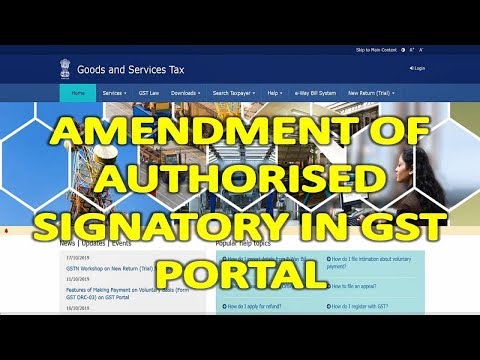Key Takeaway
- The primary authorized signatory is crucial for handling all GST-related activities and acts as the main liaison with GST authorities.
- Regular updates and modifications in GST laws require the authorized signatory to stay informed and compliant through continuous learning and use of technology.
- Changing an authorized signatory involves logging into the GST portal, making amendments in the registration core fields, and submitting necessary documentation for approval.
- In the event of a signatory’s death, immediate action is required to notify GST authorities and update the signatory details to maintain compliance and continue operations.
- The role of the authorized signatory encompasses a wide range of responsibilities, including filing returns, managing documents, and ensuring timely GST payments.
Primary Authorised Signatory in GST?
In the context of India’s Goods and Services Tax (GST), the primary authorised signatory is the individual appointed by a business to handle all GST-related activities. This person is officially designated to act on behalf of the company for performing legal and procedural duties under GST. They are registered on the GST portal and have the authority to sign and submit various GST returns and applications, making them a critical link between the business and the GST authorities.
Duties of the Primary Authorised Signatory in GST
The primary authorised signatory plays a crucial role in ensuring that the business complies with GST laws and regulations. Here are their main responsibilities:
| Duty | Description |
|---|---|
| Filing GST Returns | Responsible for preparing and submitting various GST returns such as GSTR-1 (monthly or quarterly sales return), GSTR-3B (summary return), and the annual return on behalf of the business. This involves accurate calculation and reporting of the taxes applicable. |
| Managing Documents and Records | Maintains all necessary records and documents required under GST laws, including invoices, bills of exchange, credit and debit notes, and other necessary paperwork for audit and compliance purposes. |
| Handling GST Payments | Ensures timely payment of GST due on the supplies made or received which is critical to avoid penalties and interest under GST regulations. |
| Communication with GST Authorities | Acts as the main point of contact for all communications between the business and GST authorities. This includes responding to any queries, notices, or demands from the GST department. |
| Compliance and Consultation | Advises the business on various GST compliance requirements and updates on new GST rules and regulations to ensure full compliance with the law. |
| Coordination with External Agencies | Coordinates with accountants, auditors, and consultants regarding the GST compliance of the business. They might also handle disputes and represent the company in front of GST officers during assessments or audits. |
This table presents a comprehensive overview of the responsibilities and duties of the primary authorised signatory in GST, highlighting how they manage various aspects of GST compliance and administration.
Steps to Modify the Primary Authorised Signatory
Modifying the primary authorised signatory in GST involves a series of steps that need to be followed meticulously to ensure compliance and maintain continuous operation of GST-related tasks. Here’s how you can change the authorised signatory for your business:
Step-by-Step Procedure
- Log In to GST Portal: Access the GST official website and enter your credentials to log in to the dashboard of the concerned business.
- Navigate to the ‘Amendment of Registration Core Fields’ Section: Once logged in, go to the ‘Services’ tab, click on ‘Registration’, and then select ‘Amendment of Registration Core Fields’.
- Edit the Authorised Signatory Details: In the registration amendment section, you can add new signatory details or modify existing ones. Fill in all required fields, such as the new signatory’s name, PAN, mobile number, and email address.
- Attach Necessary Documents: Upload required documents, which may include an authorisation letter or board resolution proving the appointment of the new signatory.
- Verification and Submission: After entering all details and uploading documents, verify the information through the OTP sent to the registered mobile number or email. Submit the application once everything is confirmed.
- Await Approval: The changes will be reviewed by the GST officer, and upon successful verification, the new authorised signatory will be updated in the GST records.
- Confirmation: You will receive a confirmation on your registered email once the process is complete and the new signatory is authorised to operate under GST for your business.
💡If you want to pay your GST with Credit Card, then download Pice Business Payment App. Pice is the one stop app for all paying all your business expenses.
Overcoming Challenges Faced by the Primary Authorised Signatory
The role of a primary authorised signatory comes with its set of challenges, particularly in navigating the complex landscape of GST compliance. Here are some common challenges and strategies to effectively overcome them:
Common Challenges
- Complexity of GST Laws: The constant updates and modifications in GST laws can be difficult to keep up with.
- Technical Issues with the GST Portal: Frequent glitches and downtime of the GST portal can hinder timely compliance.
- Handling Multiple Tasks: Balancing GST compliance with other business operations can be overwhelming.
Strategies for Overcoming These Challenges
- Regular Training and Updates: Stay informed about the latest GST regulations and updates by attending seminars, webinars, or training sessions offered by various organizations.
- Use of Technology: Implement GST software solutions that can help automate and manage GST filings more efficiently. This reduces the likelihood of errors and saves time.
- Delegation: Consider delegating specific tasks to other trained employees or hire a GST consultant to handle complex cases, which can help in managing workload and focusing on critical business issues.
- Maintaining Open Communication: Regularly communicate with GST officials to clarify doubts and ensure you are compliant with the latest tax norms. This can also help in resolving issues faster.
By adopting these strategies, a primary authorised signatory can effectively handle the responsibilities and mitigate the challenges associated with GST management.
Eligibility Criteria for an Authorised Signatory
When appointing an authorised signatory for GST purposes, it is essential to ensure that the individual meets specific eligibility criteria to perform the duties effectively and comply with legal requirements. Here are the primary qualifications necessary to become an authorised signatory:
General Requirements
- Citizenship: The individual must be a citizen of India.
- Age: They should be of legal age – typically 18 years or older.
- Mental Competence: The person must be mentally sound and capable of making decisions.
- Tax Compliance: They should not have any pending tax liabilities or legal penalties related to tax payments or filings.

Professional Qualifications
- Educational Background: Ideally, the authorised signatory should have a background in finance, law, or business administration to competently handle GST-related matters.
- Experience: Practical experience in tax management, accounting, or a similar field is highly beneficial.
- Identification: They must possess a valid Permanent Account Number (PAN) and be registered on the GST portal using the same.
Integrity and Reliability
- No Criminal Record: The individual should not have any criminal record, especially not related to financial fraud or misconduct.
- Reputation: They should have a good reputation and be known for integrity and ethical behavior in professional circles.
Modifying the Authorised Signatory in GST Following a Death
In the unfortunate event of the death of an authorised signatory, it is crucial to promptly update the GST records to ensure continuity in handling GST compliance. Here is the procedure to modify the authorised signatory in such cases:
Steps to Follow
- Notification: Inform the GST authorities about the death of the authorised signatory by submitting a formal notification through the GST portal. This should be done as soon as possible to avoid any disruptions in GST-related procedures.
- Documentation: Along with the notification, submit a copy of the death certificate as proof of the signatory’s demise.
- Application for Change: Log in to the GST portal and navigate to the ‘Amendment of Registration Core Fields’ section under the ‘Services’ tab. Here, you can initiate the process to change the authorised signatory.
- New Signatory Details: Provide the details of the new authorised signatory. This includes their name, PAN, contact details, and any other information required by the portal.
- Supporting Documents: Attach supporting documents such as a board resolution or a letter of authorisation from the company, indicating that the new individual is authorised to act as the signatory for GST purposes.
- Verification and Submission: Verify all the details and documents, and submit the application. An OTP may be sent to the new signatory’s registered mobile number or email for verification purposes.
- Approval: The change will be reviewed by the GST authorities, and once approved, the new signatory will be recorded in the GST system.
- Confirmation: You will receive a confirmation on the registered contact details once the new authorised signatory is updated successfully in the GST records.
It is important to handle this transition smoothly and quickly to maintain compliance with GST regulations and ensure that all tax-related responsibilities are managed without interruption.’
Crafting an Authorised Signatory Letter

Creating an authorised signatory letter is an important step in formally designating someone to handle all GST-related tasks for your business. This document should clearly outline the roles and responsibilities bestowed upon the signatory, and must be properly formatted to ensure legality and compliance.
Key Elements to Include in an Authorised Signatory Letter
Introduction
- Start with the name of the company and the date on which the letter is being written.
- Address the letter to the individual being appointed or to the relevant authorities (if necessary).
Body
- Clear Designation: State clearly that the individual is being appointed as the authorised signatory for GST matters.
- Roles and Responsibilities: Specify what their duties will be, including filing returns, managing documents, and communicating with GST officials.
- Validity: Mention the duration for which the authorisation is valid, or state that it is valid until further notice.
Conclusion
- Express confidence in the individual’s abilities to handle the given responsibilities.
- Provide contact information for any further inquiries.
Signature
- Close with a signature from a higher authority within the company, such as the CEO or Managing Director.

Sample Format for an Authorised Signatory Letter
[Company Letterhead]
[Date]
[Name of the Appointee]
[Appointee’s Address]
Dear [Appointee’s Name],
Subject: Appointment as Authorised Signatory for GST Matters
I am pleased to inform you that you have been appointed as the Authorised Signatory for [Company Name] concerning all matters related to Goods and Services Tax (GST). This appointment is effective as of [Start Date].
As the Authorised Signatory, you are empowered to act on behalf of the company in all affairs under GST, including but not limited to filing of returns, managing financial documents and records, and corresponding with the GST department.
This authorisation is valid until further notice and may be revised or revoked based on the company’s policy or if deemed necessary by the Board of Directors.
We are confident in your ability to handle these responsibilities diligently and uphold the standards of [Company Name].
Please sign and return the attached acknowledgment form to indicate your acceptance of this appointment.
Sincerely,
[Your Name]
[Your Position]
[Company Name]
[Contact Information]
Sample Format for Acceptance as an Authorised Signatory
[Company Letterhead]
[Date]
To,
The GST Department,
[Address of the Local GST Office]
Subject: Acceptance of Appointment as Authorised Signatory
I, [Your Name], hereby accept the position of Authorised Signatory for [Company Name] regarding all matters under the Goods and Services Tax (GST) as detailed in the attached appointment letter dated [Date of Appointment Letter].
I understand the responsibilities entrusted to me and commit to performing them to the best of my abilities and in compliance with all relevant laws and regulations.
Attached are the signed acknowledgment of my appointment and a copy of the appointment letter for your records.
Thank you for your attention to this matter.
Sincerely,
[Your Signature]
[Your Name]
[Your Position if Any]
[Contact Information]
This structured approach ensures that all legal bases are covered and that the appointed signatory is fully aware of their duties and the scope of their authority.
How to Update or Remove the Authorised Signatory in GST
Updating or removing an authorised signatory in the GST system is a necessary process if there are changes in the management or administrative responsibilities within a company. This can involve either changing the existing signatory to another individual or completely removing the signatory’s authorisation. Here’s a step-by-step guide on how to carry out these changes effectively and compliantly.
Steps to Update the Authorised Signatory
1. Log in to the GST Portal: Start by accessing the GST official portal (www.gst.gov.in). Enter your user ID and password to log into your GST account dashboard.
2. Navigate to the Amendment Section: Once logged in, go to the ‘Services’ menu, select ‘Registration’, then choose ‘Amendment of Registration Non-Core Fields’.
3. Modify the Authorised Signatory Details: In the amendment section, you will find a tab or section labeled ‘Authorised Signatory’. Here, you can update the details of the existing signatory or add a new signatory. You will need to fill in all the necessary information such as name, mobile number, email address, and PAN for the new signatory.
4. Attach Required Documents: Depending on the nature of the change, attach relevant documents such as a letter of authorisation, board resolution, or any other proof verifying the appointment of the new signatory.
5. Verification and Submission: Verify all the details and documents added. You may need to authenticate the submission with an OTP sent to the registered mobile number or email of the new signatory.
Submit the changes for processing.
6. Confirmation: After submission, the changes will be verified by the GST officer assigned to your case. Upon successful verification, you will receive a confirmation about the update. The new signatory details will be reflected in the GST system.
Steps to Remove the Authorised Signatory
1. Access the GST Portal: Similar to the update process, log in to the GST portal.
2. Go to the Amendment Section: Navigate to ‘Services’ > ‘Registration’ > ‘Amendment of Registration Non-Core Fields’.
3. Deactivate the Signatory: In the ‘Authorised Signatory’ tab, select the signatory that needs to be removed. There will be an option to deactivate or delete the signatory’s details. Select the appropriate option.
4. Submit Necessary Documentation: You may be required to provide a reason and supporting documentation for removing the signatory. This could include documents like a resignation letter or a new board resolution.
5. Submit and Verify: Complete the information, verify all entries, and submit the changes. The process may include OTP verification as mentioned above.
6. Await Official Confirmation: The removal of the signatory will be processed by the GST authorities. Confirmation of removal will be sent to your registered contact details.
FAQs
Who qualifies as a Non-Resident Taxable Person under GST regulations?
A Non-Resident Taxable Person in GST is someone who occasionally undertakes transactions involving the supply of goods or services in India but does not have a fixed place of business or residence in India. This individual must appoint an authorized signatory in India to comply with GST procedures and handle filings, underlining the critical role of this key stakeholder in ensuring compliance with local tax laws.
How does the Constitution of Business affect the appointment of an Authorized Signatory in GST?
The Constitution of Business plays a pivotal role in defining the eligibility and responsibilities of an Authorized Signatory under GST. Depending on whether the business is a sole proprietorship, partnership, corporation, or a Non-Resident Taxable Person, the requirements and procedures for appointing the signatory might vary, impacting the GST process and compliance strategies.
What are the typical challenges a Primary Authorized Signatory faces in the GST Process?
The Primary Authorized Signatory often faces challenges such as navigating the complexities of GST laws, managing frequent updates to the GST portal, and balancing multiple tasks which can hinder timely compliance. These issues underscore the importance of this role as a key stakeholder in the GST framework, where strategic planning and effective communication with GST authorities are essential.
What steps should be taken to modify the Authorized Signatory as per GST Procedure following the death of the previous signatory?
Following the death of an Authorized Signatory, the GST procedure requires the business to update their registration details by appointing a new signatory. This involves submitting a formal notification along with a death certificate on the GST portal, filling out the ‘Amendment of Registration Core Fields’ section, and providing the details and documents for the new signatory for verification and approval by GST officials.
Can you describe the GST Process for updating an Authorized Signatory in the case of changes in the Constitution of Business?
When there are changes in the Constitution of Business, updating the Authorized Signatory in GST involves logging into the GST portal, navigating to the Amendment of Registration Core Fields, and modifying the signatory details. This GST process ensures that the correct individual is authorized to handle GST compliance, reflecting the updated business structure and maintaining the integrity of tax filings.








